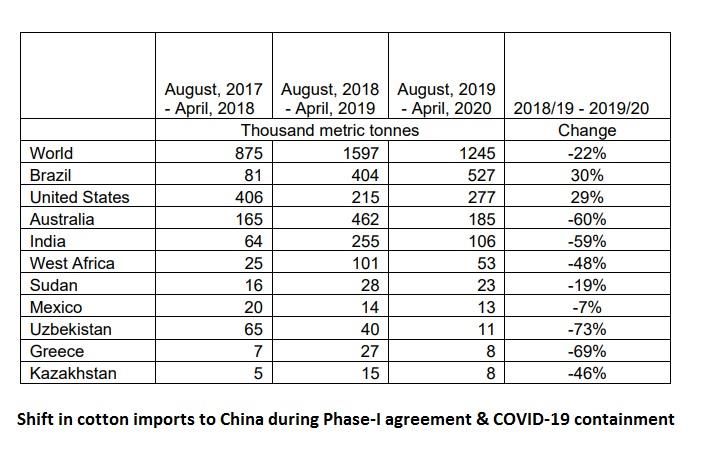
As tariffs on cotton lint increased in 2018-19, making US cotton 25 per cent more costly to Chinese importers compared to other growths, China had also increased the total volume of imports of cotton lint. As China increased its total imports of cotton lint from 1.3 million tonnes in 2017-18 to 2.1 million tonnes in 2018-19, US cotton exports to China decreased from 528,000 tonnes in 2018 to 360,000 tonnes in 2019.
"Market share in China shifted over this period with imports from Brazil increasing by over 170 per cent in 2018-19," ICAC said in its June estimate of world cotton supply and demand.
As phase one of the trade agreement entered into force, stringent COVID-19 containment measures in countries have slowed manufacturing and trade across the globe. With global cotton consumption revised down to 22.5 million tonnes for 2019-20, a 13 per cent decrease from the previous season, trade is expected to decrease to 8.25 million tonnes, an 11 per cent decrease. Imports to China have shifted again during this period of reduced demand from both COVID-19 containment and trade agreements.
Comparing the August through April period for the 2018-19 and 2019-20 seasons, global imports for the nine-month period are estimated at 1.245 million tonnes, a 22 per cent decrease from the previous period, the ICAC period said.
During the 2018-19 season, as US exports to China decreased, Brazil gained market share to China. Australia, India and West Africa also increased cotton lint exports to China during the 2018-19 season.
For the 2019-20 season, Brazil is expected to export over 1.8 million tonnes globally and through April 2020 (where the latest data is available), has exported an estimated 527,000 tonnes to China, a 30 per cent increase from the previous period. The United States is expected to export 3 million tonnes globally and through April has exported an estimated 277,000 tonnes to China, a 29 per cent increase from the previous period. Other countries and regions exporting to China that had seen increases during the 2018-19 season are showing declines in exports to China in the August through April period.
Drought conditions in Australia have limited total exports for 2019-20. Exports from India to China have decreased following an increase the previous season. Exports from West Africa (including Benin, Burkina Faso, Chad, Cote d'Ivoire, Mali and Togo) show a 48 per cent decrease over the period. Exports from other countries to China, including Sudan, Mexico, Uzbekistan, Greece and Kazakhstan, have seen decreases that range from 7 per cent to 73 per cent.
Following production and a growth in exports in 2018-19, total exports from West Africa are expected to decrease in 2019-20 to 1.1 million tonnes. With production estimated at 1.3 million tonnes for the region, stock levels would increase if quantities of the 2019-20 crop are not exported. Imports from West African countries to China have fallen by 48 per cent over the August to April period with limited opportunities to export under reduced demand from COVID-19 containment and improving trade relations between the US and China.
Fibre2Fashion News Desk (RKS)